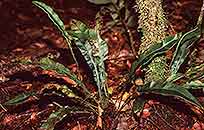Elaphoglossum zambesiacum Schelpe
Synonyms |
|
|---|---|
Common name |
|
Description |
Rhizome creeping, c. 4 mm in diameter; rhizome scales 5 × 1 mm, pale-brown, concolorous, lanceolate acuminate, margin mostly entire or with occasional hair-like outgrows. Fronds simple, closely spaced, coriaceous. Sterile fronds: stipe up to 11 cm long, pale greenish-grey or pale brown, at first set with linear, pale brown scales up to 5 mm long, later becoming subglabrous. Sterile lamina oblanceolate to narrowly elliptic in outline, apex sharply pointed, base wedge-shaped and prolonged down the axis, up to 10 × 3 cm, margin with a pale, tough border. Fertile fronds: lamina very narrowly oblanceolate, base prolonged down the axis, hairless. Sporangia covering the undersurface of the lamina. |
Notes | |
Derivation | zambesiacum: of the Zambezi region |
Habitat | Confined to higher rainfall areas, streamside rocks in shade. |
Distribution worldwide | See African distribution. |
Distribution in Africa |
|
Growth form |
Lithophytic, terrestrial. |
Literature |
|
